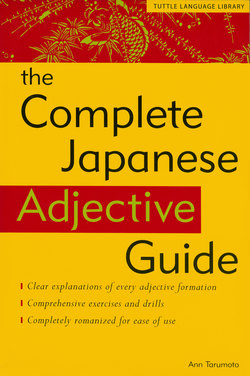Читать книгу Complete Japanese Adjective Guide - Ann Tarumoto - Страница 9
На сайте Литреса книга снята с продажи.
Оглавление13. Two or More Adjectives
Describing a Noun
So far, we’ve seen cases where the -te form is used to link adjectives in the predicate. Let’s look at cases where two or more adjectives modify a noun. If you wanted to say the phrase a big, new house in Japanese, you would use the -te form of the adjective to link it to the next. The last adjective before the noun is in the dictionary form. The phrase a big, new house in Japanese is: ookikute atarashii uchi.
Describe the following nouns with the adjectives given:
1. uchi — furui, chiisai _____________________
2. zasshi — yasui, omoshiroi _____________________
3. koora — tsumetai, oishii _____________________
4. hito — omoshiroi, ii _____________________
5. gakkoo — chikai, ii _____________________
6. kooen — ookii, chikai _____________________
7. onna no ko — chiisai, kawaii _____________________
8. hon — yasashii, omoshiroi _____________________
9. inu — ookii, kuroi _____________________
10. heya — kitanai, chiisai _____________________
By adding desu or one of its forms, you can make a complete sentence.
Try describing the following nouns using at least two adjectives. Make sure you write a complete sentence.
| Example: | meat Takakute oishii niku desu. |
When using more than one adjective to describe a noun, you do not mix favorable adjectives with unfavorable adjectives in the same phase. Therefore, you could not say an expensive, ugly house. Keep this fact in mind as you do these exercises.
1. a 280-pound weight lifter
_________________________________________
2. a Great Dane (dog)
_________________________________________
3. a frosty glass of ale
_________________________________________
4. a cashmere sweater
_________________________________________
5. a hobo
_________________________________________
6. a car you’ve had for 15 years
_________________________________________
7. Miss America
_________________________________________
8. the super express train
_________________________________________
Going back to the example of the expensive, ugly house, in Japanese, as in English, you would have to say, It is an expensive but ugly house. This is because you cannot mix adjectives with favorable and unfavorable connotations by using the -te form.
Let’s take another example:
If we were to describe a soup as being both cold and delicious, we would have to say in Japanese, It is cold but delicious soup, since cold is not consistent with the idea of delicious when speaking of most soups. In Japanese, we would use the sentence final particle ga and say, Tsumetai desu ga, oishii suupu desu.
Translate the following sentences and see if you can understand why the idea is expressed with ga as opposed to the -kute pattern you studied previously.
1. Ookii desu ga, kitanai heya desu.
_________________________________________
2. Furui desu ga, ii kuruma desu.
_________________________________________
3. Atsuku nai desu ga, oishii koohii desu.
_________________________________________
4. Kibishii desu ga, ii sensei desu.
_________________________________________
5. Ookii desu ga, kawaii inu desu.
_________________________________________
This last example may not be immediately clear. Although I personally think large dogs are cute partly because of their size, for the Japanese, the concept of cute usually implies that the object or person is small. Although the language is changing, you might still find the above way of expressing this idea clearer than ookikute kawaii inu.
